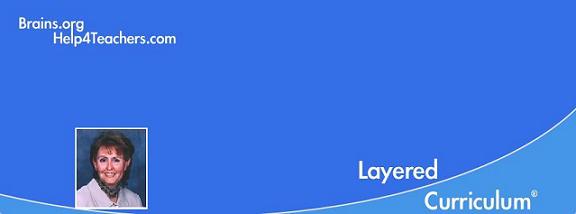__________Layered Curriculum®. . . because every child deserves a special education™_
 |
|
![]() _
_ ![]()
Layered
Curriculum TEXT & WORKBOOK
Set
for only
$43.95
(free shipping in
US)
Tweet
How the Adolescent Brain Challenges the Adult Brain
© Dr Kathie NunleyWhat makes the adolescent brain so challenging to the adult brain? Anyone who has ever tried to parent, teach or mentor the adolescent brain knows it can create some frustrating moments. A lot of this frustration can be blamed on some of the biology unique to the adolescent brain.
In any aged brain, the region responsible for basic survival needs (eat, flight/fight, sex) are handled by a region known as the hypothalamus. For obvious reason, the hypothalamus is powerful, influential and ready to function right from birth. Biologically speaking, if this area was not given top priority, the animal may not survive for long.
One of the frustrations with adolescents is due to the fact that hormones, environment, and learning, make this survival region of the brain a "hot area" in adolescent brains.
In addition, the basic survival drives of the hypothalamus don't always agree with the social structure, morals and safety of society. For the more "civilized" human behaviors we need to involve higher regions of the brain. Higher brain regions, in the cortex, can override the hypothalamus. Although these regions are not given biological priority, they are the "logical" parts of the brain and are responsible for deciding when basic hypothalamus drives may not be in our best long-term interest.
A region called the prefrontal cortex plays the role of arbitrator in making these critical decisions. It quickly sizes up the situation and makes a determination which then drives our behavior. It is the prefrontal cortex then that tells us when to act on our anger, or curtail it, eat that second piece of dessert, or go without, seek immediate gratification or hold off for the long term.
Unfortunately some people have a poorly developed or poorly functioning prefrontal cortex. These people have a hard time controlling impulsive behaviors. Head trauma, alcohol and drug abuse as well as possible genetic predispositions can all lead to a dysfunctional prefrontal cortex. Maturity also plays a big role as this area takes about 20 years to fully develop. Hence, adolescents may have problems quickly sizing up risks and making good long-term decisions.
Other biological factors make adolescent brains even more hypothalamus driven. Children learn what to do with anger by watching other people in their sphere of influence and what they do when they are angry. Peer-influence peaks during the teen-age years which means that key role models for an adolescent are other adolescents.
The hormone, oxytocin, found in the brain during romantic relationships, tends to settle and stimulate the hypothalamus during the beginning stages of the relationship. Anyone working with adolescents knows that they are always in the midst of "new love", which only further hampers logical decision making.
So adolescents appear to have at least 3 strikes against them when it comes to using logic to weigh the risks in dangerous or sometimes even everyday types of decisions. The more primitive regions of their brains are strong and tend to drive behaviors. The immature region responsible for the logic of long-term benefits does not always override the impulsive, survival-oriented hypothalamus. Add any additional trauma to the mix such as abusive households or drug and alcohol use and the issue becomes even more severe.
The biology of brain shows that adolescents still need strong adult guidance and help with decision making throughout the teen-age years . Time and good role models will fortunately allow the brain to eventually mature to match the body.
About the Author:
Dr Kathie Nunley is an educational psychologist, researcher and author of several books on parenting and teaching, including A Student's Brain (Brains.org) and the best selling, "Differentiating the High School Classroom" (Corwin Press). She is the developer of the Layered Curriculum® method of instruction and has worked with parents and educators around the world to better structure schools to make brain-friendly environments. In addition, her work has been used by the Boeing Corporation, Family Circle Magazine, the Washington Post, and ABC television.
Email her: Kathie (at) brains.orgCopyright © 1998 - current year by Kathie F. Nunley.
All Rights Reserved.
Layered
Curriculum is a registered trademark developed by
Dr. Kathie F. Nunley.